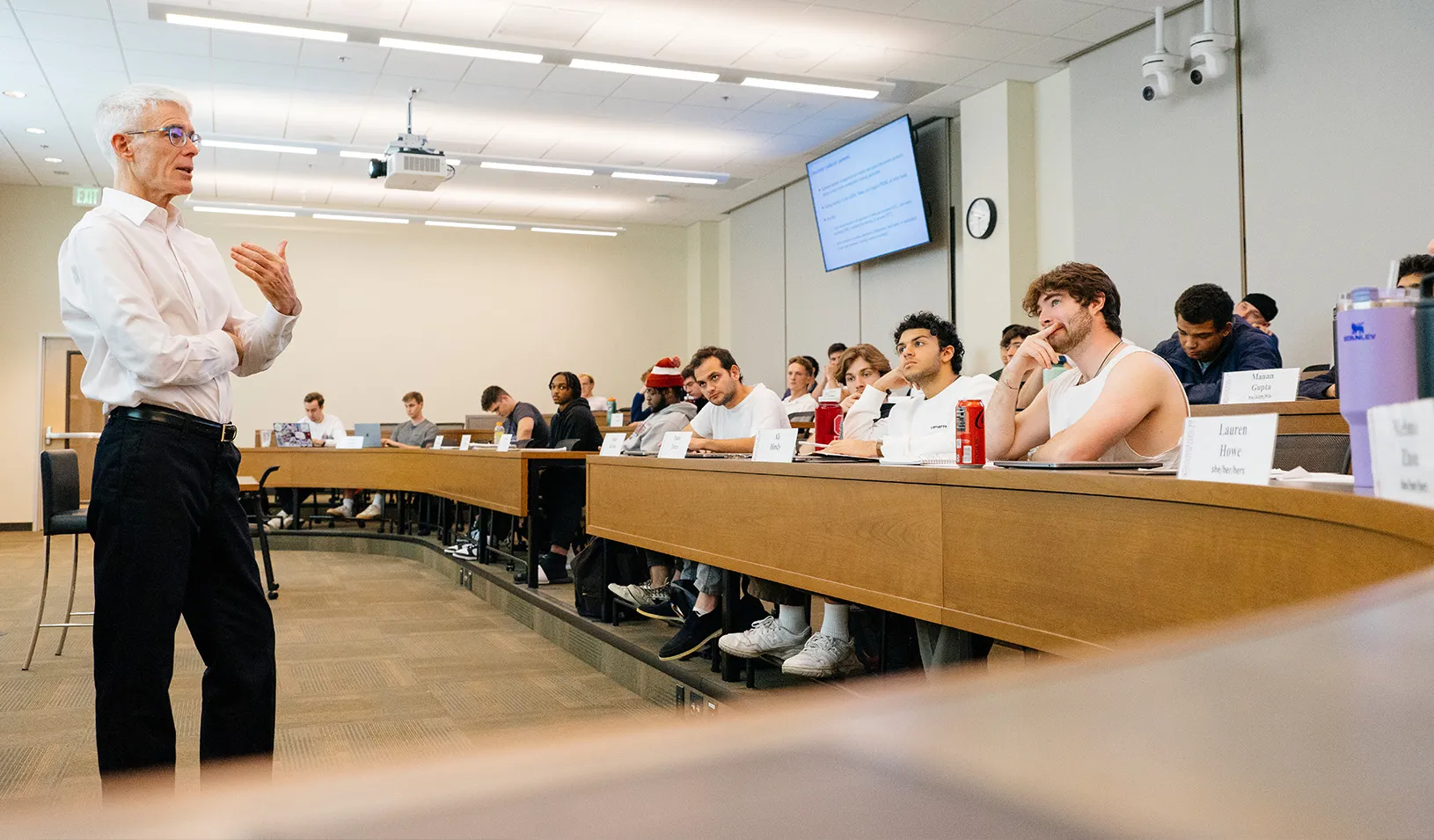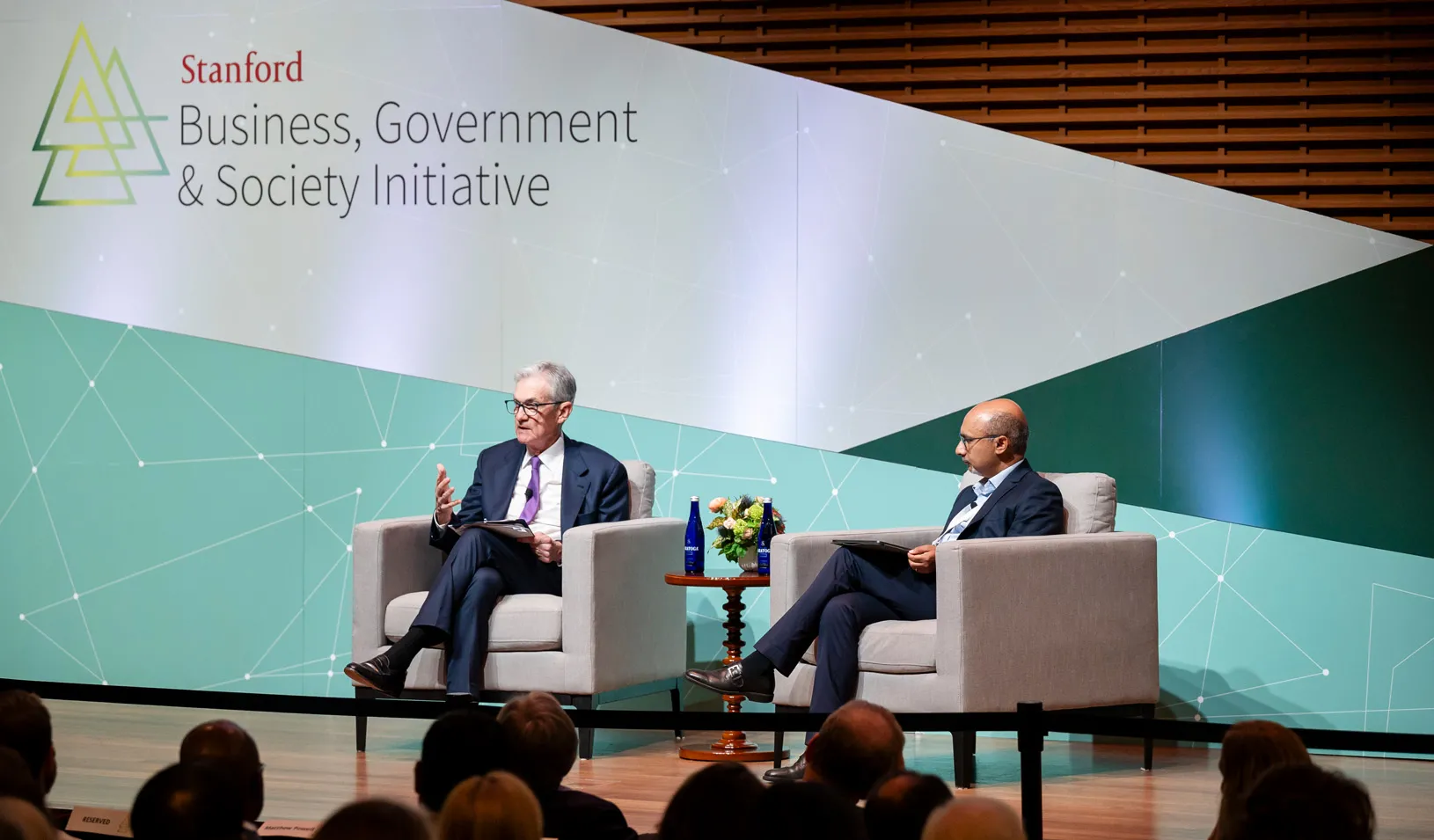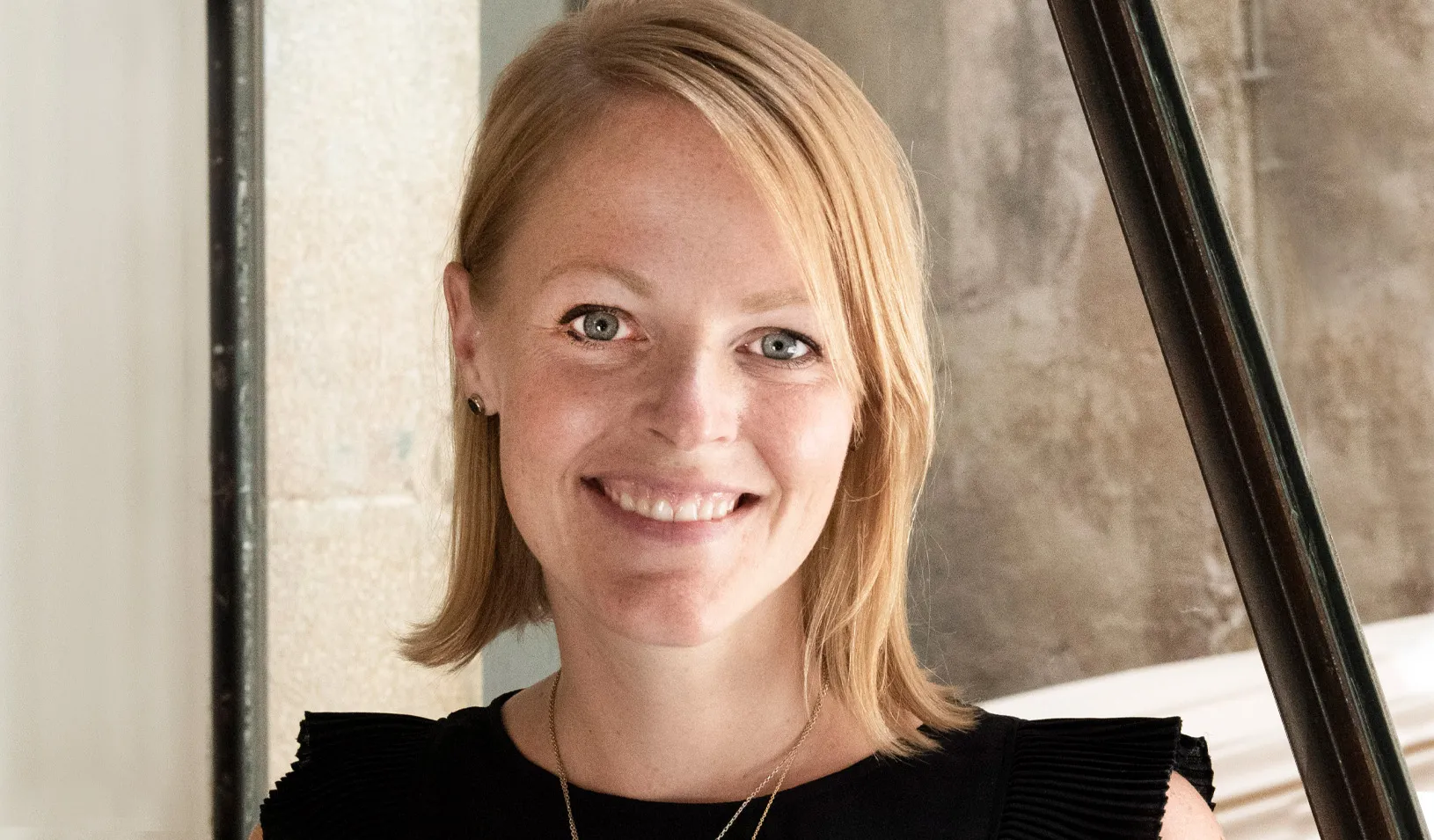Green Giants: Five Stanford GSB Alumni Quietly Pulling Levers to Save the Planet
Forget about electric cars and meatless meat: Mounting a serious response to climate change requires inventive work in less-glamorous sectors such as risk management and private equity.
April 08, 2021

“At the end of the day, climate is a leadership crisis,” says Alicia Seiger, MBA ’02. “And we need our best leaders to confront it.” | Illustration by Celyn Brazier
Experts agree: To prevent cataclysmic climate change, we must decarbonize the world economy and remove vast quantities of CO2 from the atmosphere. Individual choices like buying electric vehicles and going meatless certainly will help, but a true transition to a low-carbon future must include the combined weight of the financial system — and a whole lot of innovation.
“With COVID-19, we’ve seen that individual choices do make a difference: When everyone stays home, you can have pretty dramatic emissions reductions,” says Alicia Seiger, MBA ’02, who serves as managing director of both the Sustainable Finance Initiative and the Stanford Steyer-Taylor Center for Energy Policy and Finance.
“But that’s not how anyone wants to live their lives going forward; we are not going to get where we need to go if it’s all about sacrifice and hardship,” adds Seiger, who also teaches a course on climate, politics, finance, and infrastructure for business and law students at Stanford.
Instead, systemic transformation of everything from capital markets to corporate sustainability “is going to make for much more opportunity, and a much more rapid pathway to net-zero.” (In a net-zero world, we would remove as much carbon from the atmosphere as we put into it.)
There’s no end to the problems that climate change poses, and no single way to address them. The industrial sector needs new low-carbon business models and new carbon-removal technologies. Investors and businesses need better tools for evaluating climate risk. The financial system at large needs new mechanisms for driving capital into climate solutions. And government needs to promulgate policies that will send the right market signals.
But Seiger is hopeful, in large part because of the passion, the expertise, and the entrepreneurial mindset that Stanford GSB graduates are bringing to bear on this daunting, dizzying challenge.
“At the end of the day, climate is a leadership crisis,” she says. “And we need our best leaders to confront it.”

Nan Ransohoff, MBA ’15
Head of Climate, Stripe
The Insider
Ever since her days as an undergraduate at Harvard, where she founded a club dedicated to exploring what private markets could do to accelerate decarbonization, Nan Ransohoff, MBA ’15, has wanted to harness the power of business to address climate change. And she’s been certain that there is more than one way to get the job done.
“Every industry has a role to play in climate,” Ransohoff says.
Now, she is proving that to be true through her role at Stripe, a fintech giant that provides payment processing software — and whose primary business has nothing to do with cleantech or renewables.
In 2019, Stripe (valued at $95 billion as of March 2021) pledged that it would spend at least $1 million of its own money each year to permanently remove carbon from the atmosphere.
Developing and deploying new methods for pulling large quantities of carbon out of the sky quickly and efficiently is essential to avoiding catastrophic climate change. Stripe’s goal is therefore twofold: to speed scalable, early-stage carbon-removal technologies down the cost curve and to reassure investors that there is indeed a market for them.
“We want to be the buyer of first resort: a demand signal to entrepreneurs and researchers in building promising new carbon-removal technologies that says, ‘Hey, if you build it, people will come,’” says Ransohoff.
Ransohoff now oversees Stripe Climate, a related initiative that allows Stripe’s million-plus business customers worldwide to contribute their own money to Stripe’s carbon-removal efforts. The project was inspired by Stripe users who wanted to take climate action themselves but didn’t have the time or the resources to figure out which technologies to bet on. The company enlists a network of scientific experts to identify promising carbon-removal solutions, and a merchant anywhere in the world can opt in to the program with just a few clicks from their Stripe dashboard.
“Our thinking was, if we can make it really easy for Stripe’s million-plus users to direct a fraction of their revenue to carbon removal, we might be able to build a large-scale, voluntary market” for such startups, says Ransohoff.
More than 500 businesses have done exactly that, and Ransohoff and her team are currently exploring ways of broadening the program’s scope. One option would be to allow merchants to enable their own employees or end-users to contribute. Another might use Stripe’s credit-card-issuing business to offer customers the opportunity to purchase carbon removal with their reward points.
The success of the program has reinforced Ransohoff’s belief that there is a huge, untapped opportunity for companies of all kinds to address climate change — an opportunity that Stripe first seized for itself and is now trying to help others seize as well.
“We’re trying to make the collective action part of climate change a bit easier,” she says. “If we can convince more businesses to do even a little, we can get further, faster.”

Nicole Systrom, MBA ’14
Founder, Sutro Energy Group
The Consultant
Nicole Systrom, MBA ’14, wants to pump more capital into the clean energy sector. And she is willing to do so by any means necessary.
“My mission is to get more resources into climate-positive things,” says Systrom, who formed Sutro Energy Group just after graduating from Stanford GSB. “That means investment dollars, that means philanthropy, that means political giving, that means people’s time.”
Systrom learned firsthand the importance of having a diverse toolkit for addressing climate change: After picking up a BS in earth systems from Stanford, she raised funds for the Pacific Forest Trust, a land trust and advocacy group that works on carbon sequestration and climate change policy — only to see the American Clean Energy and Security Act, the most significant climate change bill in American history, die in the Senate in 2009.
“That experience really pushed me deeper along the path of asking, ‘What is the role of the private sector? And how can we make the economic case that this is the right direction to go?’” Systrom says.
After a stint managing greenhouse gas reduction projects at a for-profit company, Systrom came to Stanford GSB to learn more about how to use all available levers — financial, technological, societal — to achieve sustainability. In the process, she helped develop a program at the Steyer-Taylor Center for investors who are interested in assessing climate change risks and opportunities. And given the systemic nature of climate change, the economic opportunities boggled her mind.
“We have to rethink transportation, infrastructure, and buildings down to the studs,” she says. “There’s a lot to get done here.”
Systrom is doing as much of it as she can. As a consultant, she helps investors who are new to the climate space — philanthropic foundations and private investors, corporations and family offices — understand the various levers they can pull: investing in cleantech companies, funding organizations that educate legislators and the public about the need for effective climate policies, and ensuring that their own for-profits have resilience plans for climate change.
Systrom also networks with other entities and people within the sustainable-finance ecosystem who can serve as resources for her clients, such as fund managers, startups, incubators, and accelerators. Given the pressing need for innovative approaches to carbon removal, she is particularly interested in early-stage technology development. She serves on the boards of Activate, which offers financial support and entrepreneurial training to engineers and scientists working on transformative energy and climate technologies; and Prime Coalition, which channels philanthropic capital into market-based solutions to climate change that VCs might consider too risky in the early stages.
If Systrom has her fingers in a lot of pies, that’s because she’s convinced that an interdisciplinary approach is necessary to achieve change. She points to the rise of electric vehicles, which required the participation of many different actors doing many different things: philanthropists who funded research into rebate policies and contributed to politicians who would support them; investors who put up the money required to develop the technology; and financial institutions that supported the charging infrastructure necessary for deployment.
“Everyone has more tools at their disposal to affect climate than they think,” she says. “And my work is to help people put those tools to work more effectively.”

Matt Scott, MBA ’03
Senior Director, Willis Towers Watson’s
Climate and Resilience Hub
The Risk Manager
In his current position as a senior director in the Climate and Resilience Hub at Willis Towers Watson in London, Matt Scott, MBA ’03, helps clients ranging from banks and insurers to corporations and governments manage the risks — and seize the opportunities — presented by climate change and the transition to a low-carbon economy.
It’s a broad mandate. But as someone who pretty much wrote the book on climate risk and green finance, Scott is uniquely positioned to handle it.
As one of the first cohort of Stanford GSB students to take the course now known as *Design for Extreme Affordability*, Scott cofounded a startup that developed a solar LED light to replace the smoky and expensive kerosene lamps used in many parts of the developing world.
The startup was successful in bringing solar lighting to off-grid villages around the globe, but the challenges of raising funds for a social enterprise — philanthropic foundations couldn’t help because they gave grants only to charities, while venture capitalists saw a red flag in the firm’s purpose-driven approach — led Scott to explore innovative ways of driving more capital into ventures that seek to address climate change.
“I became curious about how to move mainstream markets through climate risk, because risk is such a fundamental characteristic of how financial markets function,” he says.
That curiosity led Scott to the Bank of England, where in 2015 he helped establish a global framework for thinking about the many different risks related to climate change: not only the physical risks linked to storms and floods, for example, but also the transition risks presented by carbon regulation, such as mispriced and stranded assets. He also helped spark the movement to have companies disclose their climate-related risks so that they could be priced and managed.
In 2018, Scott was seconded to the British government, where he launched the UK’s Green Finance Strategy. One of the primary goals of the GFS is to make Britain’s financial services sector more climate-friendly and competitive by adopting mandatory climate-disclosure standards and identifying opportunities to develop the climate-related data, analytics, and financial products required to shift to a low-carbon economy.
From his perch in the Climate and Resilience Hub, Scott continues to work on cultivating better tools for understanding the financial impact of climate risk. And he uses his knowledge of policy, financial regulation, and green finance to help clients around the world assess and put price tags on the risks and opportunities that come with climate change so that they can better allocate their capital.
The stakes are high: One way or the other, Scott says, climate-related risks will ultimately affect every corner of the economy. The good news is that investors, corporations, and other actors in the financial system can mitigate those long-term risks by actively stewarding the transition to a low-carbon world — as soon as possible.
“It’s not just about managing the near-term risks and being resilient to changing weather,” Scott says. “The actions that are taken over the next decade will determine the balance of future risks.”

Megan Starr, MBA ’15
Global Head of Impact, the Carlyle Group
The Investor
How can investors make choices that are both economically rational and environmentally correct?
That was the fundamental question that drew Megan Starr, MBA ’15, to Stanford GSB. And as global head of impact at the Carlyle Group, a private equity fund with $246 billion of assets under management, she gets to answer it every day.
Raised on Cape Cod by parents who were committed environmentalists — “I grew up in a house that they built by hand; we had solar panels for electricity, and grew our own food,” she recalls — Starr was not an obvious candidate for a career in private equity.
“I was not a capital markets girl,” she says.
Instead, Starr studied environmental science at Harvard with the renowned climatologist Daniel Schrag, then spent several years at a philanthropic foundation supporting action on climate change. That experience led her to wonder how the 95% of the foundation’s endowment that was invested rather than disbursed through grants could be used to solve environmental and social challenges. She says Stanford GSB gave her the tools she needed to figure that out, and after helping build the impact investing and environmental, social, and governance desks at Goldman Sachs, she ascended to her current position at Carlyle.
Starr leads a team of experts who integrate climate into every aspect of Carlyle’s business. That includes helping the firm’s deal teams consider climate-related factors when performing due diligence on individual companies; increasing the value of those companies by working with them to boost energy efficiency and prepare for a net-zero future; and pricing climate risks and opportunities across the firm’s entire portfolio.
Last year, for example, Starr had a climate-risk consultant help her group vet a portfolio of assets to understand how climate risks such as sea-level rise and extreme weather could affect insurability and therefore pricing decisions.
The team also carbon-footprinted the firm’s majority-owned portfolio companies in its three primary private equity funds for the very first time. The idea, Starr explains, was not to sort businesses into good and bad buckets based on a static snapshot of their emissions, but rather to figure out how companies could leverage — and improve — their sustainability profiles to drive better business performance and financial outcomes.
The exercise paid off: Some companies were able to identify millions of dollars of potential savings by spotting inefficient energy use, while others were able to capitalize on their relatively low-carbon footprints by creating differentiated pricing among consumers who appreciate a climate-friendly profile.
Under Starr’s guidance, the firm has also begun to link debt financing to environmental goals. In one case, Starr and her colleagues have been measuring the carbon-emissions benefit of a major manufacturer’s technology versus that of its peers. The price of the company’s debt is now linked to specific emission-reduction goals.
“As they hit those goals, their debt gets slightly cheaper,” says Starr. She sees the arrangement as a prime example of how investors can incentivize better climate performance alongside profitability. In her view, those two things aren’t just compatible; they’re inextricably intertwined.
“Our goal as a private investor is to build better businesses, because better businesses are worth more,” Starr says. “And the world has changed such that the dimensions of better business are inclusive of climate resilience and opportunity.”

Nicholas Flanders, MBA ’16
CEO, Opus 12
The Entrepreneur
Nicholas Flanders, MBA ’16, is living the dream.
As a sci-fi fan growing up on a farm in upstate New York, Flanders was steeped in both nature and technology. After working in the clean technology practice at McKinsey & Company and helping lead a tech startup in New York City, he came to Stanford GSB with the goal of launching his own cleantech firm.
Today, Flanders is CEO of Opus 12, a startup built around cleantech hardware that uses electricity from renewable sources such as wind and solar to transmute carbon dioxide and water into gold — or, more precisely, into valuable products like jet fuel and plastic.
The company’s core invention is a device that relies on novel chemical catalysts developed by Flanders’ cofounders, Kendra Kuhl and Etosha Cave, both of whom earned PhDs in chemical engineering at Stanford. (The two were part of the Jaramillo Research Group, which has done pioneering work on converting CO2 into fuels and chemicals using renewable energy.)
Their goal is to offer carbon emitters the opportunity to recycle their CO2 emissions into revenue-producing chemicals and fuels, while at the same time reducing the companies’ output of a harmful greenhouse gas. If deployed on a grand-enough scale, Flanders says, it could address as much as 10% of global carbon emissions.
It has other advantages as well: The catalysts are packaged in a device that can be dropped into existing industrial machinery, much as you might pop a new chip into an old laptop, allowing users to quickly bolt the technology directly onto their existing infrastructure.
And it makes carbon removal painless: Using nothing but CO2, water, and renewable power, the device generates the building blocks of chemicals that are identical to ones normally derived from fossil fuels — chemicals such as ethylene, a principal ingredient in most plastics; and carbon monoxide, which can be used to produce fuel for aircraft.
But even when you have a potentially revolutionary technology on your hands, building a viable cleantech firm is far more difficult than cooking up a new software app — especially when serious scientific R&D is required.
“You need more infrastructure than just a laptop and a couch to get started,” says Flanders, who notes that he and his cofounders received early funding from Stanford’s TomKat Center for Sustainable Energy.
After founding the company in 2016, the team spent two years building its first prototype with support from Cyclotron Road, a Department of Energy-funded program hosted by Lawrence Berkeley National Lab.
They needed more funding from government agencies like NASA and the National Science Foundation to develop a device with industrial performance and scalability. (NASA hopes to use Opus 12 tech to manufacture rocket fuel and other mission-critical products on Mars, using the planet’s atmosphere and water as feedstocks.)
And to persuade investors the technology had legs, they relied on early buy-in from potential customers like the oil giant Shell, which selected Opus 12 to participate in a program designed to support early-stage cleantech.
“We needed all of that to raise our first dollar of outside funding,” Flanders says.
But raise it they did. Total funding since its founding runs into the tens of millions of dollars, and Opus 12 now has relationships with companies such as SoCalGas and Mercedes-Benz, which last year used Opus 12 tech to produce the world’s first plastic car part made from CO2. The team has expanded to include a few dozen employees, most of them chemists and engineers who are developing a bigger version of the device. And Flanders looks forward to making large-scale supply agreements with customers over the next couple of years.

“We’re trying to make the collective action part of climate change a bit easier.” — Nan Ransohoff, MBA ’15 | Illustration by Celyn Brazier
For media inquiries, visit the Newsroom.
Explore More
Back to Class: Pathfinder

Business, Government, and Society Forum Looks at New Demands on Leadership

Erin Nixon Joins Stanford GSB as Assistant Dean of Admissions
